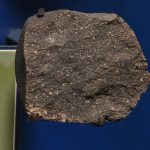The ratio of hydrogen isotopes in meteorite’s water resembles the composition of water on Earth.
Key takeaways
- The Winchcombe meteorite, a rare carbonaceous type, fell in the UK and was quickly recovered for study.
- Scientists found that 11% of the meteorite’s weight is extraterrestrial water, similar in composition to Earth’s water.
- The meteorite also contains amino acids, essential for life, suggesting that ingredients for life on Earth came from space.
- The meteorite offers a glimpse into the early solar system’s composition, dating back 4.6 billion years.
- The study supports the idea that carbonaceous asteroids helped deliver water and other life-building materials to early Earth.
A rare carbonaceous meteorite fell into a Gloucestershire driveway. The meteorite, named Winchcombe, was discovered barely hours after its fireball lit up the skies above the UK.
A year later, specialists from the Natural History Museum and the University of Glasgow confirmed that the 4.6 billion-year-old meteorite contained extraterrestrial water, offering compelling proof that water on Earth may be traced back to asteroids in the outer solar system. The findings are reported in Science Advances.
Researchers were able to immediately retrieve the meteorite owing to public reports and video footage of the fireball acquired by 16 cameras coordinated by the UK Fireball Alliance.
Winchcombe contains 11% extra-terrestrial water
“Winchcombe’s rapid retrieval and curation make it one of the most pristine meteorites available for analysis, offering scientists a tantalizing glimpse back through time to the original composition of the solar system 4.6 billion years ago,” Dr. Ashley King of the Natural History Museum, and author on the paper, said in a statement.
Winchcombe is a rare CM carbonaceous chondrite with 2% carbon, and it is the first meteorite of this type discovered in the UK.
The researchers conducted thorough imaging and chemical studies and discovered that Winchcombe contained around 11% extraterrestrial water by weight. The majority of it is in minerals created by chemical interactions between fluids and rocks on its parent asteroid in the early phases of the solar system, according to the announcement.
When the scientists examined the ratio of hydrogen isotopes in the water, they discovered that it nearly matched the makeup of water on Earth. The meteorite fragments also included extra-terrestrial amino acids, which are prebiotic chemicals required for the formation of life.
The meteorite provides the powerful link yet between carbonaceous meteorites and asteroids
These findings suggested “carbonaceous asteroids played a key role in delivering the ingredients needed to kickstart oceans and life on the early Earth” .
The study also determined that Winchombe was ejected off the surface of an asteroid near Jupiter and subsequently transported to Earth during the last million years.
“One of the most often asked topics in the scientific community is how we got here. Dr. Luke Daly, a lecturer in Planetary Geoscience at the University of Glasgow and the paper’s author, stated that this research of the Winchcombe meteorite sheds light on how the Earth came to have water, which is the source of much life. “Researchers will continue to work on this specimen for years to come, unlocking more secrets into the origins of our solar system.”


